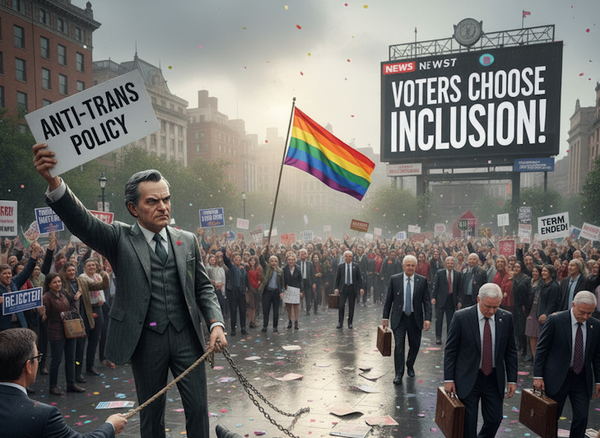Big Oil spills $450 million into influencing Trump, Republicans as oil production reaches record high
“Donald Trump’s day-one actions have shown where his loyalties lie – executing the industry’s wishlist at the expense of working Americans."

Washington, D.C. – Big Oil spent $450 million to influence Donald Trump and Republicans throughout the 2024 election cycle and 118th Congress, an analysis by Climate Power reveals. This funding includes direct donations, lobbying, and advertising to support Republicans and their policies.
“The oil and gas industry spent a whopping $450 million to influence Donald Trump and Republicans,” said Alex Witt, Climate Power senior advisor for oil and gas, in a statement. “That investment is already paying off.”
“Donald Trump’s day-one actions have shown where his loyalties lie – executing the industry’s wishlist at the expense of working Americans. Trump’s energy agenda will raise costs for families, strip away energy choices, dirty our air and water, and put 400,000 new clean energy jobs at risk,” Wittman concluded.
In the 2024 election cycle, oil and gas donors spent:
- $96 million in direct donations to support Donald Trump’s presidential campaign and super PACs between January 2023 and November 2024
- $243 million lobbying Congress
- Nearly $80 million on advertising supporting Trump and other Republicans or policy positions supported by their campaigns
- More than $25 million to Republican down-ballot races, including $16.3 million to Republican House races, $8.2 million to Republican Senate races, and $559,049 to Republican Governors.
“At closed-door meetings at Mar-a-Lago and swanky industry fundraisers, Trump made wooing the industry a top campaign priority—and it worked. Oil billionaires like Continental Resources’ Harold Hamm, Energy Transfer Partners’ Kelcy Warren, and Hilcorp Energy Co.’s Jeffrey Hildebrand gave millions to his campaign and affiliated PACs,” the report states.
The report concludes:
Trump’s close ties to oil and gas executives and his willingness to prioritize their agenda underscore the relationship between his political ambitions and Big Oil’s financial goals.
As he enters his second term, Trump has promised to implement an oil and gas industry wishlist—a wishlist that will undercut competition from clean energy, raise utility bills for families, and send hundreds of thousands of good-paying clean energy jobs to China.
While Trump has deceptively claimed he is declaring an “emergency” to produce more energy and lower costs, his first actions actually aim to crush some of America’s most abundant energy supplies—because his agenda is geared toward maximizing oil industry profits rather than American energy production. The only way for the U.S. to truly become a global energy superpower is to free ourselves from Big Oil's grip and invest in the clean energy of the future.
Read the full analysis HERE
The fossil fuel industry donations produce the results desired
The donations definitely produced the results desired by the oil and gas industry. During his Inaugural Address, President Donald Trump unveiled his plan to quickly enact a number of executive orders concerning energy and the environment in his complete denial of the climate change crisis that is now ravaging the planet.
These include a “national energy emergency” to encourage more oil and gas production; opening up new federal lands to fossil fuel extraction; ending environmental justice programs across the country; and canceling clean energy incentives, according to a statement from Food & Water Watch.
Trump also announced his plan to withdraw from the Paris Climate Accord, as he did in his first administration.
Here’s Trump’s statement on the White House website:
MAKE AMERICA AFFORDABLE AND ENERGY DOMINANT AGAIN
- The President will unleash American energy by ending Biden’s policies of climate extremism, streamlining permitting, and reviewing for rescission all regulations that impose undue burdens on energy production and use, including mining and processing of non-fuel minerals.
- President Trump’s energy actions empower consumer choice in vehicles, showerheads, toilets, washing machines, lightbulbs and dishwashers.
- President Trump will declare an energy emergency and use all necessary resources to build critical infrastructure.
- President Trump’s energy policies will end leasing to massive wind farms that degrade our natural landscapes and fail to serve American energy consumers.
- President Trump will withdraw from the Paris Climate Accord.
- All agencies will take emergency measures to reduce the cost of living.
- President Trump will announce the America First Trade Policy.
- America will no longer be beholden to foreign organizations for our national tax policy, which punishes American businesses.
As expected, there was not a word in Trump’s statement addressing the increasingly dramatic impacts of climate change on the U.S. and the world.
U.S. reached a new high in crude oil production in 2025
U.S. crude oil production reached record highs under the Biden Administration — and the U.S. Energy Information Agency (EIA) forecasted that U.S. crude oil production will rise to a new high under the second Trump administration: https://www.eia.gov/outlooks/steo/index.php.
U.S. crude oil production (million barrels per day) was 12.0 in 2022, 12.9 in 2023 and 13.2 in 2024. The EIR forecasted that there would be a new record high of 13.5 million barrels per day in 2025 under Trump. They were right about a new record high under Trump — but in fact the amount of crude oil produced was even higher than forecasted.
“In July, U.S. crude oil production averaged more than 13.6 million b/d, the most in any month on record,” according to the EIA’s latest report. “Production in July was higher than we previously estimated, which raised the starting point for our U.S. crude oil production forecast. In addition, we raised our forecast for crude oil production in the Gulf of America (sic) as some projects are ramping up production faster than we had expected. Although we expect crude oil production will decline from its recent peak as oil prices fall, we now forecast U.S. crude oil production will average 13.5 million b/d in both 2025 and 2026. Our 2026 forecast increased by 0.2 million b/d from last month.”
The bottom line here is that U.S. has produced more crude oil over the past 3 years and in 2025 to date than any other nation in history. Yes, the U.S. is the world's largest oil producer as the climate crisis intensifies, as evidenced by the apocalyptic fires in the LA Area earlier this year.
Big Oil spent a record $31.4 million in first 9 months of 2024 in CA
Meanwhile in California, the oil and gas industry spent over $26 million in the first three quarters of 2025 in their successful effort to stop the Make Polluters Pay Climate Superfund Act, AB 1243 and SB 684, and other climate legislation, from moving forward this year.
The huge gusher of fossil fuel cash also enabled the industry to pressure legislative leaders to pass Governor Gavin Newsom’s trailer bill, SB 237, to expand oil drilling in Kern County by 2,000 new well permits per year, despite intense political opposition to the bill by a coalition of environmental justice, community and public interest groups.
On September 19, Governor Gavin Newsom signed SB 237 as part of a climate package at a carefully staged press conference at the California Academy of Sciences in San Francisco.
Big Oil spent $7,217,466 in the third quarter of the year, less than the $9,206,886 they spent in the second quarter and the $9,139,655 spent in the first quarter, but still a huge amount of oily cash: cal-access.sos.ca.gov/...
It’s no surprise that the majority of this fossil fuel cash was spent by Chevron and the Western States Petroleum Association, consistently the top lobbying spenders in Sacramento.
Chevron spent $2,642,118 in the third quarter, less than the $4,396,429 spent in the second quarter and the $3,889,907 spent in the first quarter. That comes to a total of $10,928,454 that Chevron spent lobbying California officials from January 1 through September 30 of this year.
Chevron has refused to respond to growing calls to boycott the company for its operation and co-ownership of Israeli-claimed fossil gas fields in the Mediterranean. At Chevron stations across the country, including in the Sacramento area and the San Francisco Bay Area, local human rights and environmental justice groups have been holding regular protests to highlight the company’s complicity in genocide, as well in environmental destruction and human rights violations across the globe.
The Western States Petroleum Association (WSPA) finished second in the fossil fuel lobbying expenses with $2,375,251, less than the $3,032,226 spent in the second quarter and the $3,471,879 spent in the first quarter.
That comes to a total of $8,879,356 that the Western States Petroleum Association spent lobbying California officials from January 1 through September 30, 2025.
When you combine the lobbying expenses of WSPA and Chevron in the first three quarters, it comes to a grand total of $19.8 million!
Chevron and the Western States Petroleum Association spend more than any other corporate lobbying organizations in Sacramento every year.
Last year the Western States Petroleum Association placed first in the Big Oil lobbying spending spree with $17.4 million, while Chevron came in second with $14.2 million. Spending by the Western States Petroleum Association and Chevron alone shattered the previous record, coming in at $31.6 million in 2024, according to data compiled by the Last Chance Alliance: lastchancealliance.org/...
In addition, Sable Offshore, the corporation that plans to restart the pipeline that caused the devastating Refugio Oil Spill that fouled the Southern California coastline in 2015, spent $120,000 in the third quarter. That comes after they spent $419,000 lobbying state officials in the second quarter of 2025 to fight a bill, AB1448, that would prevent drilling on public lands.
Another major fossil fuel industry spender on lobbying was Sempra Energy and its affiliates, including the San Diego Gas & Electric Company and SoCalGas, the company responsible for the Aliso Canyon gas blowout of 2015, the biggest of its kind in U.S. history. Residents of Porter Ranch and nearby communities have been urging Newsom to shut down the SoCalGas underground gas storage facility since he became Governor.
Sempra spent $1,057,159 on general lobbying and another $25,237 on lobbying the California Public Utility Commission in the third quarter. The company spent $604,629 on general lobbying in the second quarter and $430,718 in the first quarter.
Western States Petroleum Association (WSPA) is a “non-profit trade association that represents companies that account for the bulk of petroleum exploration, production, refining, transportation and marketing in the five western states of Arizona, California, Nevada, Oregon, and Washington. WSPA’s headquarters is located in Sacramento, California. Additional WSPA locations include offices in Torrance, Concord, Ventura, Bakersfield, and Olympia, Washington,” according to WSPA’s website.
WSPA and the oil companies wield their power in 8 major ways: through (1) lobbying; (2) campaign spending; (3) serving on and putting shills on regulatory panels; (4) creating Astroturf groups; (5) working in collaboration with media; (6) sponsoring awards ceremonies and dinners, including those for legislators and journalists; (7) contributing to non profit organizations; and (8) creating alliances with labor unions, mainly construction trades.
The top five lobbying and influence spenders for Q3 can be seen in the table below, followed by the top spenders this year to date (YTD), according to data compiled by the Last Chance Alliance:
Top 5 lobbying and influence oil industry spenders in Q3:
Company | Q3 Lobbying Money Spent |
Chevron U.S.A., Inc. and Affiliates | |
Western States Petroleum Association | |
Phillips 66 | |
California Resources Corporation and Subsidiaries | |
PBF Holding Company |
Top 5 lobbying and influence oil industry spenders YTD (Q1-Q3)
Company | YTD Lobbying Money Spent |
$10,315,939.56 | |
$8,879,357.31 | |
$717,802.21 | |
$683,380.58 | |
$667,003.63 |




